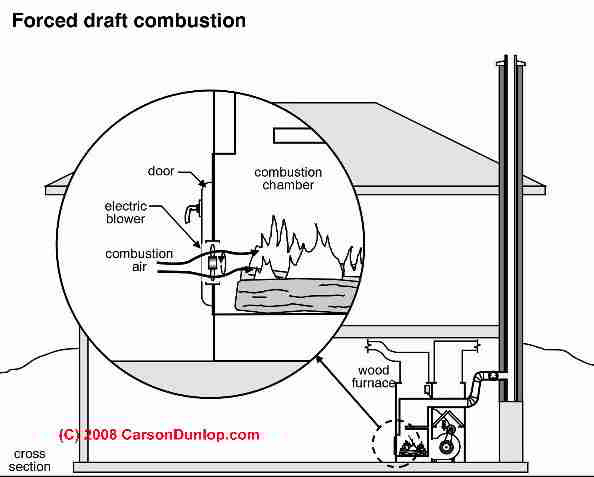
Ü If the unit smells excessively of oil, test for oil leaks and repair the leaks. Ü Inspect heat exchanger and combustion chamber for cracks, corrosion, or soot buildup. Ü Inspect burner and appliance for signs of soot, overheating, fire hazards, corrosion, or wiring problems. Assure that all 120-volt wiring connections are enclosed in covered electrical boxes. Ü Verify that each oil furnace or boiler has a dedicated electrical circuit. Safety Inspection, Testing, and Adjustment Persistent unsatisfactory test results may indicate the need to replace the burner or the entire oil-fired heating unit. An oil burner that passes visual inspection and complies with the specifications on page 261 may need no maintenance.

Use visual inspection and combustion testing to evaluate oil burner operation. SWS Detail: 5.3003.4 Evaluating Electrical Service Ü Adjust the airflow or the water flow to reduce high flue-gas temperature if possible, but don’t reduce flue-gas temperature below 350☏.Ĩ.6.2 Oil Burner Inspection and Maintenance Ü Measure the transformer voltage, and adjust it to manufacturer’s specifications if necessary. Ü Measure the oil-pump pressure, and adjust it to manufacturer’s specifications if necessary. Adjust the thermostat’s heat anticipator to match the amperage, or read the thermostat manufacturer’s instructions for adjusting cycle length. Ü Adjust the gap between electrodes and their angle for proper alignment. * pmi = per manufacturer’s specifications Positive-pressure burner with horizontal vent and without a barometric control: Positive-pressure burner with atmospheric chimney and barometric control: Oil pressure pounds per square inch (psi)


Table 8-5: Minimum Oil Burner Combustion StandardsĬarbon monoxide (CO) parts per million (ppm as measured) Smoke number should be near zero on all modern oil-fired equipment. Ü Adjust oxygen, flue-gas temperature, CO, and smoke number to match manufacturer’s specifications or specifications given here. Ü Adjust the air shutter to achieve the oxygen and smoke values, specified in Table 8-5 on page 261. Ü Adjust the barometric damper for a negative overfire draft of –0.020 IWC or –5 pascals at a test plug in the heating unit. If the nozzle is oversized, replace the burner nozzle after selecting the correct nozzle size, spray angle, and spray pattern. Exceptions: steam boilers and boilers with tankless coils. Ü A flue gas temperature more than 450° F is a sign that a clean heating unit is oversized. Ü Measure the overfire draft over the fire inside the firebox through a plug in the heating unit. Analyze the flue gas for O 2, flue-gas temperature, CO, and steady-state efficiency (SSE). Ü Sample undiluted flue gases between the barometric draft control and the appliance. Ü If the smoke number is higher than 3, take steps to reduce smoke before sampling the gases with a combustion analyzer to prevent the smoke from fouling the analyzer. Compare the smoke smudge left by the gases on the filter paper with the manufacturer’s smoke-spot scale to find the smoke number. Ü Sample the undiluted flue gases with a smoke tester, after reading the smoke tester instructions. Unless the oil-fired heating unit is very dirty or disabled, technicians should do combustion testing and adjust the burner for safe and efficient operation.Ĭombustion testing is essential to understanding the current oil burner performance and potential for improvement. Applications include: fireplace inserts, furnaces, boilers, and water heaters.SWS Detail: 5.3003.2 Combustion Analysis of Oil-Fired Appliances Use with gas, wood pellet, oil, or wood appliances.
#FURNACE FLUE DRAFT CONTROL 5 INCH PROFESSIONAL#
DuraFlex AL is recommended for professional installationsĭuraFlex SS offers smooth wall flexible relining for masonry chimney. DuraLiner is recommended for professional installationsĭuraFlex AL is an economical relining system used for relining masonry chimney for natural gas or liquid propane category I, draft hood equipped appliances, and appliances tested and listed to use Type B Gas Vent for a wide range of applications. This brand is recommended for Do it Yourself Homeowners, as well as professional installersĭuraLiner is an insulated, double-wall masonry relining system that ensures safe and efficient venting from heating appliances, while protecting your masonry chimney from the damaging effects of flue gas. They are intended for use with masonry chimneys venting appliances that burn home heating oil, LP or natural gas and solid fuels including wood, coal and pellets.

Lifetime Chimney Liner - Lifetime Chimney Liners are strong, flexible liners that are constructed with 316L grade stainless steel.


 0 kommentar(er)
0 kommentar(er)
